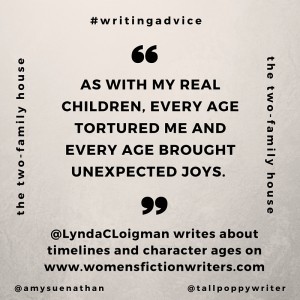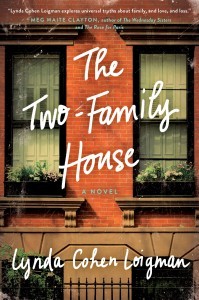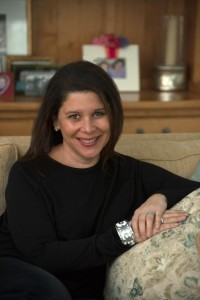Guest Post: Lynda Cohen Loigman’s Tips For Timelines and Storytelling
Lucky me! I read Lynda Cohen Loigman’s debut novel, THE TWO-FAMILY HOUSE well over a year ago. Lucky you! THE TWO-FAMILY HOUSE hit bookstores and bookshelves just two days ago so now you can read it too!
I was so taken with this story that I think about it even now. The story spans two decades and follows two families through tragedy and triumph. One of the things that fascinated me was the timeline. My stories happen in a short period of time. The Glass Wives story occurred over a matter of months, as did The Good Neighbor. My third novel’s timeline spans a week. So, when an author is about to take me through characters’ entire lives, and do it well, I’m captivated.
As you will be with this stunning debut novel.
Please welcome Lynda Cohen Loigman to WFW and congratulate her on her debut novel!
Amy xo

Timelines and Storytelling: My Favorite Age
 I first started thinking about the story for The Two-Family House sixteen years ago. I knew it would focus on a family secret, but more interesting than the secret itself would be the havoc it wreaked as the years progressed. After pondering structure and time lines, I finally realized that in order to tell the story properly, I would have to cover a period of at least twenty years. I was so intimidated by the prospect that I couldn’t bring myself to write a single word.
I first started thinking about the story for The Two-Family House sixteen years ago. I knew it would focus on a family secret, but more interesting than the secret itself would be the havoc it wreaked as the years progressed. After pondering structure and time lines, I finally realized that in order to tell the story properly, I would have to cover a period of at least twenty years. I was so intimidated by the prospect that I couldn’t bring myself to write a single word.
Perhaps the most daunting aspect of writing a “multigenerational family saga” (aside from the fact that it’s a bit of a tongue twister to pronounce) is writing about characters as they age. Think about the movies you’ve seen – in order to show the passing of time, Hollywood doubles up on grey hair dye, prosthetic noses and fake wrinkles. Authentic aging is a tough thing to present, whether on the screen or on the page. Physical development, emotional growth, shifts in attitude and priorities – how could I possibly hope to achieve all that in a believable way over two decades? I had a fairly solid grasp of my adult character and the arcs they would follow, but what about their children? The idea of beginning a story with pregnancy and writing about unborn children from birth to adulthood seemed more overwhelming than raising my real children.
At some point, the need to write the story became stronger than my fear, and I began. Luckily, the structure I had chosen worked in my favor. Writing from the alternating viewpoints of the six main characters provided the opportunity to dig deeply into each individual’s thoughts and motivations. It allowed me to write about a single day or moment from multiple perspectives. Slowing down time helped me to control it, and I realized I didn’t have to talk about every day of every week of every year. I could skip to the most significant events. I could work my way through the calendar and stop only when I needed to.
Although I was beginning to grow more comfortable, I dreaded getting to the place in the story where the babies were born. When a movie takes a character from childhood to adulthood, multiple actors are often used. To write from the perspective of a child who grows up, I would need to use multiple voices, and blend them together seamlessly enough so that one whole person emerged.
Writing about Judith first was helpful. At twelve, she was already a fully formed person, complete with preferences, quirks and opinions. Because Judith is an “old soul” when we meet her, it wasn’t that much of a leap to take her from adolescence to her thirties. There was no doubt that Natalie, who we first meet at birth, would be more of a challenge to portray.
If you are a parent, you’ve probably had one or more strangers approach you at a park or grocery store and ask how old your child is. Whatever your answer – three months, one year or seventeen, chances are that someone has replied, “That is the best age,” or “That age is my favorite.” Even if you don’t talk to strangers, you’ve probably made a similar comment to a friend or family member at least once. Your six-month-old who can’t talk back? The sweetest. Your three-year-old who sleeps through the night? The best! Your ten-year-old who showers on her own and makes her own bed? What could be better? Every age has its delights and its challenges, because every age allows us to experience something new and different about our children.
Although The Two-Family House introduces Natalie at birth, the book is almost half over when the chapters written from her point of view appear. The reader hears from her at age five, eight, nine, thirteen and twenty-two. As with my real children, every age tortured me and every age brought unexpected joys. I found that in order to present each age in the most believable way, it was best to focus on the individual moment, and to stop myself from worrying about what was coming next. I had to write in linear fashion – year by year. It was impossible to skip ahead, because until I explored who Natalie was at age nine, I couldn’t understand who she would become by age thirteen.
Writing twenty-two years worth of story wasn’t easy, and I’m honestly surprised that it didn’t take me twenty-two real years to write. But now that it’s done, I’m so happy that I didn’t let my dread of covering such a long period of time stop me from writing the story. There is no question about it – time is a tricky element in a novel. Move too slowly, and the story will drag. Progress too quickly, and the character development will feel shallow and rushed. It’s hard to know whether I succeeded, but I’m proud that I made it through to the end.
Recently, someone asked me which age I enjoyed writing about most in the story. Did I prefer writing about Judith at twelve or Judith at sixteen? Was it more fun to describe five-year-old Natalie or Natalie at twenty-two? The fact is, the answer is the same whether children are fictional or real.
Every age is my favorite.
 Lynda Cohen Loigman grew up in Longmeadow, MA. She received a B.A. in English and American Literature from Harvard College and a J.D. from Columbia Law School. She is a student of the Writing Institute at Sarah Lawrence College, and lives with her husband and two children in Chappaqua, New York. She is a failure at enforcing reasonable bedtimes. THE TWO-FAMILY HOUSE is her first novel.
Lynda Cohen Loigman grew up in Longmeadow, MA. She received a B.A. in English and American Literature from Harvard College and a J.D. from Columbia Law School. She is a student of the Writing Institute at Sarah Lawrence College, and lives with her husband and two children in Chappaqua, New York. She is a failure at enforcing reasonable bedtimes. THE TWO-FAMILY HOUSE is her first novel.
Find out more about Lynda and THE TWO-FAMILY HOUSE:
Women's Fiction Writers
- Amy Sue Nathan's profile
- 543 followers



